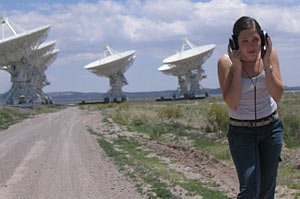The song of killer electrons

Light and sound are two fairly different things. They're both waves, but their similarity ends there. Sound is a compression wave: something happens (like a tree falling in a forest) that compresses air a little bit, and that wave travels outward at - shockingly - the speed of sound. Your ears detect it, and your brain translates it into sound.
 Light is an electromagnetic wave. The whole story is fairly complicated, but it's an oscillation of electric and magnetic fields, and doesn't need a medium (like air or water) through which to travel.
Light is an electromagnetic wave. The whole story is fairly complicated, but it's an oscillation of electric and magnetic fields, and doesn't need a medium (like air or water) through which to travel.
But because they're both waves, light and sound have a frequency and an amplitude. If you're clever - and we humans are - you can convert one to the other... well, more like translate one to the other. It's not like it's a real conversion, with physical meaning (like converting feet to meters). But it can make for an interesting, and lovely, experience.
In August 2012, NASA launched a pair of satellites called Radiation Belt Storm Probes. They are designed to detect the electromagnetic radiation (also called EM for short) emitted as charged particles bip and bop around Earth's magnetic field, high above the surface. Various phenomena in the geomagnetic field produce radio waves - which are a form of light, but too low energy for our eyes to detect. These waves can have the same frequency as sound waves we can hear - a few Hertz, or oscillations per second - so they can be directly translated into sound. Scientists did that using RBSP data, and it sounds eerie and beautiful.
Here's the sound file of these waves. It's... odd. Like birdsong, but unearthly. You can understand why scientists call these waves "chorus".
And they're handy, too. Translating light to sound in this way can be helpful in understanding it, much like creating color pictures helps astronomers understand data better. The folks at NASA put together this video to explain all this:
This is actually pretty important stuff. Electrons blown from the Sun in the solar wind get trapped in Earth's magnetic field, like bugs in a net. Usually these are low energy particles, which eventually follow the magnetic field lines to the Earths poles, where they are deposited safely into our atmosphere. But sometimes, something caffeinates these electrons, pumping them up to very high energies. They travel so quickly that if they hit one of our satellites, they can damage the electronics! The reasons benign particles can turn into "killer electrons" isn't well understood, but it may have to do with these chorus waves. Understanding them better means we can protect our satellites better, and since we spend trillions of dollars on satellites, there's some decent motivation to make sure they work well.
Also? It's just cool. If you like the killer electron song, then you'll get a kick out of other sounds created the same way, from the aurora to meteors burning up in our atmosphere! You'll find links to those listed in Related Posts below.
Image of my good friend Dr. Nicole Gugliucci, aka Noisy Astronomer, used totally without her permission. Won't she be surprised?
Related Posts:
- Hear the Sun's roar
- Listen in on the Perseid meteor shower
- Saturn, the Forbidden Planet
- Phoenix sings
- Laying down the pulsar beat


























